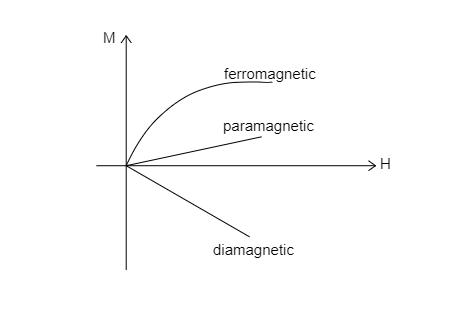
Susceptibility of a ferromagnetic substance is _______________ .
A) > 1
B) < 1
C) Zero
D) 1
Answer
474k+ views
Hint: Susceptibility of a material is defined as the ratio of the magnetization of the material to the field intensity. Ferromagnetic materials are substances that get strongly magnetized when placed in an external field. This suggests that they have large positive values for susceptibility.
Formula used:
Susceptibility of a material is given by, ${\chi _m} = \dfrac{M}{H}$ where $M$ is the magnetization of the material and $H$ is the magnetic intensity of the applied field.
Complete step by step answer:
Step 1: Mention the features of ferromagnetic substances which result in high positive values for susceptibility ${\chi _m}$ .
Ferromagnetic materials when placed in an external magnetic field get strongly attracted to the magnetic field. In the absence of the magnetic field, the dipole moments of the atoms interact with each other and spontaneously orient themselves along a common direction leading to the formation of domains. Each domain has a different direction. So when no external field is present, there is no bulk magnetization. But in the presence of a magnetic field, all these domains will align themselves in the direction of the applied field and thus give rise to strong magnetization. Now even if the field is removed, the magnetization persists in them and can be made to zero only on increasing the field in the reverse direction. So ferromagnetic materials are usually preferred to make permanent magnets.
Thus the susceptibility of a ferromagnetic material must be greater than 1. i.e., ${\chi _m} = \dfrac{M}{H} > 1$ where $M$ is the magnetization of the material and $H$ is the magnetic intensity of the applied field. So, the correct option is A.
Additional information:
The susceptibility of paramagnetic materials has small positive values whereas, diamagnetic materials have small negative values for susceptibility.
A graph depicting the difference in the susceptibility of the three different materials is given below.

Note:
Magnetic susceptibility is basically a measure of how well a given magnetic material gets magnetized. The susceptibility will be positive if the material gets attracted to the external field and it is negative if the material repels the external field. Ferromagnetic materials are strongly attracted to magnets.
Formula used:
Susceptibility of a material is given by, ${\chi _m} = \dfrac{M}{H}$ where $M$ is the magnetization of the material and $H$ is the magnetic intensity of the applied field.
Complete step by step answer:
Step 1: Mention the features of ferromagnetic substances which result in high positive values for susceptibility ${\chi _m}$ .
Ferromagnetic materials when placed in an external magnetic field get strongly attracted to the magnetic field. In the absence of the magnetic field, the dipole moments of the atoms interact with each other and spontaneously orient themselves along a common direction leading to the formation of domains. Each domain has a different direction. So when no external field is present, there is no bulk magnetization. But in the presence of a magnetic field, all these domains will align themselves in the direction of the applied field and thus give rise to strong magnetization. Now even if the field is removed, the magnetization persists in them and can be made to zero only on increasing the field in the reverse direction. So ferromagnetic materials are usually preferred to make permanent magnets.
Thus the susceptibility of a ferromagnetic material must be greater than 1. i.e., ${\chi _m} = \dfrac{M}{H} > 1$ where $M$ is the magnetization of the material and $H$ is the magnetic intensity of the applied field. So, the correct option is A.
Additional information:
The susceptibility of paramagnetic materials has small positive values whereas, diamagnetic materials have small negative values for susceptibility.
A graph depicting the difference in the susceptibility of the three different materials is given below.

Note:
Magnetic susceptibility is basically a measure of how well a given magnetic material gets magnetized. The susceptibility will be positive if the material gets attracted to the external field and it is negative if the material repels the external field. Ferromagnetic materials are strongly attracted to magnets.
Recently Updated Pages
Using the following information to help you answer class 12 chemistry CBSE

Full Form of IASDMIPSIFSIRSPOLICE class 7 social science CBSE

In case of conflict between fundamental rights of citizens class 7 social science CBSE

Can anyone list 10 advantages and disadvantages of friction

What are the Components of Financial System?

Complete the letter given below written to your Principal class null english null

Trending doubts
Show variation of resistivity of copper as a function class 12 physics CBSE

Electrolysis of dilute H2SO4 generates H2S2O8 What class 12 chemistry CBSE

Explain with a neat labelled diagram the TS of mammalian class 12 biology CBSE

How do you convert from joules to electron volts class 12 physics CBSE

A convex lens is placed in water Its focal length A class 12 physics CBSE

Distinguish between asexual and sexual reproduction class 12 biology CBSE




